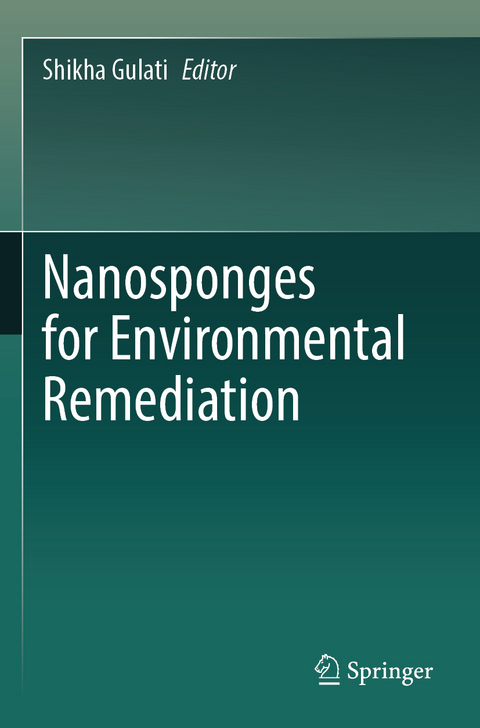
Nanosponges for Environmental Remediation
Springer International Publishing (Verlag)
978-3-031-41079-6 (ISBN)
The book covers the chemistry of various nanosponges, as well as the methods for synthesizing them and altering them chemically, as well as their characterization and uses in environmental remediation. Sensors, adaptable materials for oil clean-up in the sea, the removal of dangerous organic and inorganic pollutants from wastewater, the adsorption of various poisonous and greenhouse gases from the air, and more are just a few of the environmental uses for nanosponges. This book aims to provide broad coverage of recent research progress or up-to-date knowledge addressing various aspects in this field. With this book, we aim to provide the readers with the opportunity to learn about different facets of environmental remediation using nanosponges. Thus, this book scrutinizes the state-of-the-art research and discovery in the use of nanosponges in environmental applications, highlighting the scope to which these novel materials have been incorporated by the community. Beyond bestowing asummary of recent research by major groups in the field, the book presents the approaches behind recent developments, providing a long-lasting situation for experienced researchers and novices in the field. This book also emphasizes the challenges with previous signs of progress and way for further research, details relating to the current pioneering technology, and future perspectives with a multidisciplinary approach. Furthermore, it presents up-to-date information on the economics, toxicity, and regulations related to these novel materials. This book is of interest to those in environmental science and applications, particularly graduate students, young faculty, and others exploring nanosponges.
Dr. Shikha Gulati is working as an Assistant Professor of Chemistry at Sri Venkateswara College, University of Delhi. Her research interests are in the area of Inorganic Chemistry, Nano-materials, Green Chemistry, Medicinal Chemistry, Catalysis, Organometallics, Bio-inorganic Chemistry, and Analytical Chemistry.
1. Introduction to Nanosponges.- 2. General Synthetic Routesfor Different Types of Nanosponges.- 3. ImportantFunctionalization strategies for Nanosponges.- 4. Characterizationtechniques for Nanosponges.- 5. Different types of Nanosponges used in environmental remediation.- 6. Introduction to Cyclodextrin-Based Nanosponges.- 7. Synthesis, functionalization strategies and application of different types of Cyclodextrin-Based Nanosponges for water treatment.- 8. Introduction to Metal-organic Framework Sponges and their Synthetic and functionalization strategies.- 9. Application of Metal-organic Framework Sponges for toxic or greenhouse Gas Adsorption.- 10. Metal-organic Framework Sponges for Water remediation.- 11. Introduction to Spongelike Functional Materials from TEMPO-Oxidized Cellulose Nanofibers.- 12. Synthesis and application of types of Metal Oxide Nanosponge in water treatment.- 13. Synthesis and Applications of Metal and Metal Oxide-based Nanosponges assensors.- 14. Cellulose-based Nanosponges for the removal of metal ions from wastewater.- 15. Application of nanosponges for aquifer bioremediation.- 16. Nanostructured sponges for the removal of toxic dyes from wastewater.- 17. Environmental application of nanosponges to clean up oil spills.- 18. Polymer-based Nanobiocomposite as a Filter Nanosponge for Wastewater remediation.- 19. Removal of Organic and inorganic Contaminants from Water Using Nanosponge Cyclodextrin Polyurethanes.- 20. Concluding remarks & future perspectives of Nanosponges in environmental remediation.
| Erscheinungsdatum | 13.10.2024 |
|---|---|
| Zusatzinfo | XXIV, 473 p. 139 illus., 104 illus. in color. |
| Verlagsort | Cham |
| Sprache | englisch |
| Maße | 155 x 235 mm |
| Themenwelt | Naturwissenschaften ► Biologie ► Ökologie / Naturschutz |
| Naturwissenschaften ► Chemie ► Technische Chemie | |
| Naturwissenschaften ► Geowissenschaften | |
| Schlagworte | Chemistry of nanosponges • Dangerous organic and inorganic pollutants • Environmental remediation • Materials for oil clean-up • Wastewater and greenhouse gases |
| ISBN-10 | 3-031-41079-3 / 3031410793 |
| ISBN-13 | 978-3-031-41079-6 / 9783031410796 |
| Zustand | Neuware |
| Informationen gemäß Produktsicherheitsverordnung (GPSR) | |
| Haben Sie eine Frage zum Produkt? |
aus dem Bereich


